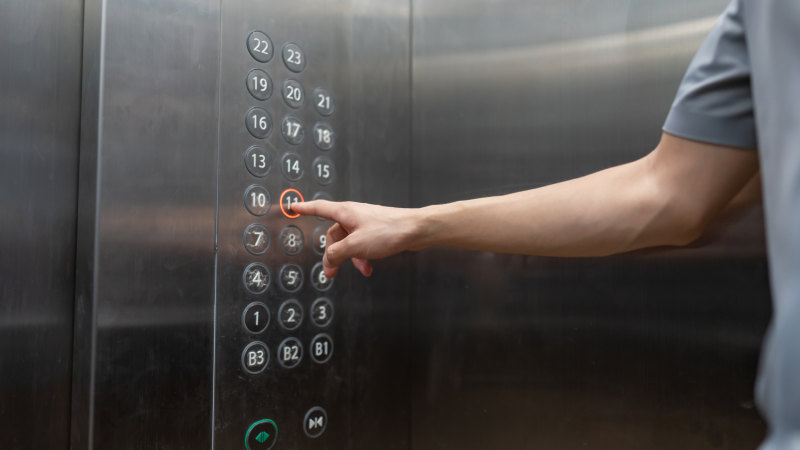Save articles for later
Add articles to your saved list and come back to them any time.
Reading the news in the past few weeks has frequently left me feeling nauseous, faint and panicked. If it wasn’t the story of a woman from Ecuador knocking from the inside of her coffin during her wake, it was an article about the Titan submersible and its final journey, trying to reach the Titanic wreck 4000 metres below the ocean’s surface.
My feelings were real – and unsettling – but didn’t extend as far as some people’s more debilitating fear of confined spaces. Giles Kirkham, 49, is one of thousands of Australians who has been diagnosed with claustrophobia. “I wouldn’t go in a submarine, even if the hatch was open,” he says.
Research suggests around two per cent of people have been diagnosed with a marked fear of closed spaces.Credit: iStock
Dr Corrie Ackland, clinical psychologist at the Sydney Phobia Clinic, says claustrophobia is a fear of enclosed spaces severe enough to impact day-to-day life. “Lifts and medical procedures, like MRIs, are common triggering environments,” she says. “Some people avoid flying and others are unable to sit in certain rooms.”
“My claustrophobia manifests itself mainly in lifts,” says Kirkham, who lives in Melbourne’s eastern suburbs. “But I’ve also had panic episodes while wearing a thick wetsuit and being crammed in the back of a small three-door car.”
Kirkham’s fear of lifts sees him climbing a lot of stairs, including to the 30th floor of a hotel building while on holiday. Though he has developed personal tactics that can allow him to use bigger and more modern lifts, the mental strain and physical symptoms he experiences have been a substantial problem for his software sales work, which involves meetings in multi-storey buildings.
Giles Kirkham, 49, is one of many Australians who have been diagnosed with claustrophobia.
“People tend to think of phobias as not serious, but they can be debilitating,” says Professor Bronwyn Graham, a clinical psychologist whose research at UNSW focuses on the treatment of phobias. Graham also notes that though we do not have Australian data on how common phobias are, international studies indicate that around two per cent of people have been diagnosed with a marked fear of closed spaces, with women three times more likely to be affected than men.
Contrary to popular belief, not everyone’s fear is triggered by a horrific experience. Instead, genetics and learned fear from others often play a role. “My mum hated going in lifts, and we’d think it was hilarious, so would jump up and down,” Kirkham recalls from his early childhood. “Then I had a lift pause before the doors opened – just for 20 seconds – but it triggered something, then I started avoiding them.“
Unlike other anxiety disorders, medication doesn’t work for phobias. Exposure – a clinical term for ‘facing the fear in a supported way’ – is the standard treatment for claustrophobia, as well as other phobias like a fear of spiders, heights, flying or blood.
Seeking treatment helped Kirkham, though years of COVID lockdowns prompted a setback. “It’s got quite bad again,” he says.
Ackland says Kirkham isn’t alone. “We’re seeing phobias [coming] back and often people are in a worse position,” she says. “That’s because, even through no fault of our own, if the practice of exposure isn’t maintained, the fears will freshen back up.“
Treatment plans for claustrophobia are often centred around exposure. “We start by educating the client on what’s got them to this point, then help with anxiety management strategies, such as controlled breathing and relaxation techniques, as well as thought-based strategies,” explains Ackland.
Virtual reality programs can be useful to simulate fearful situations, but the real work is done in the real world. “We’re often up at Centrepoint Tower and on trains that go through tunnels,” says Ackland.
According to Graham, research suggests treatment can be done in a single prolonged session rather than multiple sessions over weeks or months. She emphasises it’s crucial that exposure therapy is finely tuned to each individual’s fear. This is something that Kirkham – who was more afraid of the plane ride than the jump when he went parachuting – completely understands.
“My ultimate fear is getting trapped and, for me, that’s about control,” says the father of three, who hopes his children won’t develop a similar phobia. “So, trying to mimic the feeling by getting into a cupboard, for example, doesn’t work for me because I know I could open the door anytime.”
Despite his fears of feeling trapped, Kirkham has not avoided news stories about the Titan. “I got all the feelings while reading and watching the videos, but they weren’t extreme,” he says.
And experts say this is a positive approach. “You don’t need to push yourself all the way into these stories, but you certainly don’t want to feel you have to avoid them altogether,” Ackland says.
As someone who’s been surprised by the feelings recent events have been capable of evoking, I’ll heed this advice and take heart from Ackland’s humanising of our fears: “People with empathy and imaginations will always be able to put themselves into these stories of people’s dire circumstances”.
Make the most of your health, relationships, fitness and nutrition with our Live Well newsletter. Get it in your inbox every Monday.
Most Viewed in Lifestyle
From our partners
Source: Read Full Article


